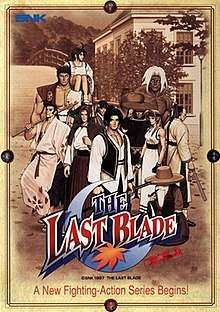The Last Blade
The Last Blade[lower-alpha 2] is a fighting game developed and released by SNK for the Neo Geo system in 1997. It was also ported to several home systems. A sequel, The Last Blade 2, was released in 1998.
| The Last Blade | |
|---|---|
 | |
| Developer(s) | SNK[lower-alpha 1] |
| Publisher(s) | SNK
|
| Director(s) | Kimura Ken |
| Producer(s) | Akira Goto Hiroshi Matsumoto |
| Designer(s) | Econo Daisuke Eiji Fukatsu H. Taniguchi |
| Programmer(s) | Naoyan Apchiba |
| Artist(s) | Toshiaki Mori |
| Writer(s) | Hidetaka Suehiro[1] |
| Composer(s) | Hiroshi Yamazoe Yasuhiro Naka Yasuo Yamate |
| Series | The Last Blade |
| Platform(s) |
|
| Release | 1997
|
| Genre(s) | Fighting |
| Mode(s) | |
| Cabinet | Upright |
| Arcade system | Neo Geo MVS |
| CPU | M68000 (@ 12 MHz), Z80A (@ 4 MHz) |
| Sound | YM2610 (@ 8 MHz)[2] |
| Display | Raster, 320 × 224 pixels (Horizontal), 4096 colors |
The game takes place during the Bakumatsu era in Japan, and incorporates various elements of Japanese mythology (with a heavy emphasis on the symbology of the Four Symbols). As such, the background music generally incorporates synthesized instruments simulating a sound appropriate to the 19th century setting, in a Western classical, pseudo-Romantic style (unusual for a fighting game).
Gameplay
The Last Blade series is seen as a spiritual successor to SNK's popular Samurai Shodown series, due to it being a similar 2D weapons-based fighting game. The gameplay is characterised by two selectable fighting styles, and a unique combo system along with a "deflect" system which involves pressing the D button at an opponents attack. Upon deflecting, the opponent is left open to attack.
The two styles consist of two modes: Speed mode and Power mode. Speed mode allows players to chain several normal attacks into a special or desperation/super move, as well as execute a Speed Combo. Power mode on the other hand, grants the player increased damage potential exponentially and giving access to Super Desperation Moves which inflict an exorbitant amount of damage (the prerequisites to performing them however, requires the player's life bar to flash and have a full power bar). Power mode also allows the player to perform Super Cancels; canceling a special move into a desperation/super move (but not a desperation move, with the sole exception of Awakened Kaede in the first game).
Characters
All of the characters in the Last Blade series are of Japanese origin, excluding Lee Rekka, who is from China, and Yuki, who is from Russia. Some characters, such as Akatsuki Musashi and Lee Rekka, are based on historical or legendary figures. A number of characters from the Last Blade series also appeared in SNK Playmore's Neo Geo Battle Coliseum.
Ports and re-releases
The Last Blade was subsequently bundled with the sequel The Last Blade 2 for a PlayStation 2 compilation released only in Japan titled Bakumatsu Roman Gekka no Kenshi 1・2 on January 12, 2006;[3] both games are arcade perfect emulations of the original games. The PlayStation version was re-released for PlayStation 3 via PlayStation Network in Asia on May 31, 2007 and later for Vita.
It was re-released for Wii via the Virtual Console by D4 Enterprise in Japan on March 13, 2012,[4] in North America on June 7, 2012,[5] and in PAL regions on August 2, 2012.[6]
A port for Microsoft Windows, OS X, Linux and asm.js developed by DotEmu was released by SNK Playmore as part of the Humble NEOGEO 25th Anniversary Bundle on December 8, 2015.[7][8] It was released on Steam on August 31, 2016,[9][10] and on GOG.com on May 30, 2017.[11]
Hamster Corporation re-released the game as part of their ACA Neo Geo series for Xbox One via Xbox Games Store on May 18, 2017; for PlayStation 4 via PlayStation Store in Japan on May 18, 2017, in PAL regions on May 25, 2017 and in North America on June 15, 2017; for Nintendo Switch via Nintendo eShop on December 14, 2017;[12] and for Windows 10 via Microsoft Store on February 28, 2018.
Notes
References
- Suehiro, Hidetaka (February–March 2011). "Game Design in the Coffee. Lovable Game Design by SWERY". Game Developers Conference. Informa. Retrieved 2020-05-10.
- "SNK NeoGeo MVS Hardware (SNK)". system16.com. Retrieved 2020-05-10.
- Niizumi, Hirohiko (6 April 2005). "Last Blade compilation to PS2 in Japan". GameSpot. Archived from the original on 28 July 2019. Retrieved 28 July 2019.
- van Duyn, Marcel (29 February 2012). "Japanese Virtual Console List - March 2012". Nintendo Life. Archived from the original on 4 March 2012. Retrieved 28 June 2019.
- Newton, James (7 June 2012). "Nintendo Download: 7th June 2012 (North America)". Nintendo Life. Archived from the original on 9 June 2012. Retrieved 28 June 2019.
- Whitehead, Thomas (30 July 2012). "Nintendo Download: 2nd August 2012 (Europe)". Archived from the original on 2 August 2012. Retrieved 28 June 2019.
- Conditt, Jessica (8 December 2015). "Play 19 SNK games in a browser via the Neo Geo Humble Bundle". Engadget. Retrieved 27 June 2019.
- Devore, Jordan (8 December 2015). "This Humble Neo Geo Bundle is real tempting". Destructoid. Retrieved 27 June 2019.
- ""THE LAST BLADE" is finally out on Steam!|NEWS RELEASE|SNK USA". SNK. 1 September 2016. Retrieved 28 June 2019.
- Romano, Sal. "The Last Blade released for PC via Steam". Gematsu. Retrieved 2016-08-31.
- "Release: 15 SNK NEO・GEO Classics". GOG.com. CD Projekt. 30 May 2017. Retrieved 28 June 2019.
- Brian (6 December 2017). "The Last Blade is next week's NeoGeo game on Switch". Nintendo Everything. Archived from the original on 28 July 2019. Retrieved 28 July 2019.
.png)